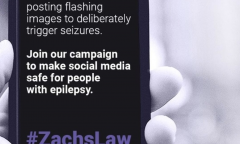TikTok to introduce feature that filters photosensitive videos
Epilepsy Society welcomes the news that TikTok is introducing a new feature that filters photosensitive videos. This is a significant step in helping to safeguard users with epilepsy.
The platform’s new feature will allow users to filter content that falls within the photosensitive range and remove it from their TikTok feed. Potentially photosensitive content will carry a warning and will give users the option to filter all future photosensitive videos. The feature is scheduled to be launched in January 2021.
TikTok is a video sharing platform with 3.7 million daily active users in the UK alone. This equates to approximately 1100 people with photosensitive epilepsy in the UK using the platform. With 800 million active users worldwide, approximately 240,000 people with photosensitive epilepsy will be using the platform.
Epilepsy Society raised concerns with TikTok around harmful content on the platform after being alerted by the charity’s supporters to strobe video filters and “seizure challenge” trends. The charity hopes this will encourage other social media platforms to introduce robust software to safeguard users with epilepsy from online harm.
Nicola Swanborough, Acting Head of External Affairs at the Epilepsy Society has said: “It is extremely encouraging to see a platform with such a significant following as TikTok introducing algorithms to detect photosensitive content and protect people with epilepsy. We hope that the platform’s new feature will turn up the heat on other big players in the industry to take the safeguarding of its users with epilepsy seriously.
"TikTok’s move has demonstrated that where there is a will to do so, technology can be developed at speed to protect people from physical and emotional harm. Our message to the other social media companies is clear; if TikTok can do it, so can you!”
Support our #ZachsLaw campaign
Write to your MP
We are asking you to write to your local MP, asking for their support in including people with photosensitive epilepsy in the government’s Online Harms Bill.

